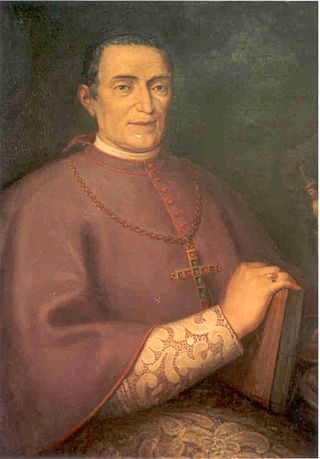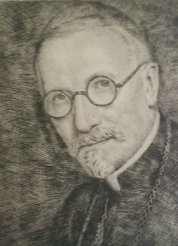The Roman Curia comprises the administrative institutions of the Holy See and the central body through which the affairs of the Roman Catholic Church are conducted. The Roman Curia is the institution which the Roman Pontiff ordinarily makes use of in the exercise of his supreme pastoral office and universal mission in the world. It is at the service of the Pope, successor of Peter, and of the Bishops, successors of the Apostles, according to the modalities that are proper to the nature of each one, fulfilling their function with an evangelical spirit, working for the good and at the service of communion, unity and edification of the Universal Church and attending to the demands of the world in which the Church is called to fulfill its mission.

The Congregation for the Evangelization of Peoples was a congregation of the Roman Curia of the Catholic Church in Rome, responsible for missionary work and related activities. It is also known by its former title, the Sacred Congregation for the Propagation of the Faith, or simply the Propaganda Fide. On 5 June 2022, it was merged with the Pontifical Council for Promoting the New Evangelization into the Dicastery for Evangelization.

Joseph Rosati, CM was an Italian-born Catholic missionary to the United States who served as the first bishop of the Diocese of Saint Louis between 1826 and 1843. A member of the Congregation of the Mission, in 1820 he was appointed provincial superior over all the Vincentians in the United States.
In Christianity, inculturation is the adaptation of Christian teachings and practices to cultures. This is a term that is generally used by Catholics, whereas Protestants, especially associated with the World Council of Churches, prefer to use the term "contextual theology".

The Roman Catholic Diocese of Natchitoches was a residential episcopal see of the Catholic Church from 1853 to 1910 and is now a titular see.

Celso Benigno Luigi Costantini was an Italian Roman Catholic cardinal and the founder of the Disciples of the Lord who served as the Apostolic Chancellor from 1954 until his death. He became a cardinal in 1953. He is best known for his work in China. Costantini dedicated himself to improving the work of missionaries and believed that evangelization in China belonged to the Chinese people. His time there heralded countless successes and he was careful never to involve himself in the complex politics between the Church and the state.
The Living Rosary Association was founded on 8 December 1826 by Pauline Marie Jaricot in Lyon, France. The association was formally approved by the Catholic Church through a canonical letter in February, 1827. The aims of the association were two; to bring the people of France to a prayerful way of life and distribute Catholic literature and devotional articles. The original Living Rosary Association slowly declined; however, the tradition has been revived in a variety of forms.

Charles-Auguste-Marie-Joseph, Count of Forbin-Janson, C.P.M., was a French aristocrat and prelate who was a founder of the Fathers of Mercy, established in an effort to re-evangelize the French people. He preached throughout North America, taking an active role in reviving the Catholic populations of the United States and Canada. He was influential in establishing an ultramontane stand in the Catholic Church in French-speaking Canada, an influence which would last for generations.
The Leopoldine Society was an organization established in Vienna for the purpose of aiding Catholic missions in North America. Based on the French model of the Society for the Propagation of the Faith, the Leopoldine Society was founded in 1829 in Vienna, and named in memory of the Emperor's daughter.

Pauline Marie Jaricot was a French member of the Third Order of Saint Dominic. She also was the founder of the Society of the Propagation of the Faith and the Association of the Living Rosary. Pope John XXIII ratified the first step of her beatification process, declaring her venerable. On 26 May 2020, Pope Francis recognized a miracle attributed to her intercession as the final requirement for beatification.

The Pontifical Association of the Holy Childhood or Missionary Childhood Association, is a Catholic children's association for the benefit of foreign missions. It is one of four Pontifical Mission Societies and is dedicated to fostering children’s awareness of the missionary nature of the Church.
Edmond John Fitzmaurice was an Irish-born American prelate of the Roman Catholic Church. He served as bishop of the Diocese of Wilmington in Delaware from 1925 to 1960.

Richard Vincent Whelan was an American prelate of the Roman Catholic Church. He served as bishop of the Diocese of Richmond in Virginia (1841–1850) and as bishop of the Diocese of Wheeling in West Virginia (1850–1874).

Ralph Leo Hayes S.T.D. was an American prelate of the Roman Catholic Church. He served as the fourth bishop of the Diocese of Helena in Montana from 1933 to 1935, and as the fifth bishop of the Diocese of Davenport in Iowa from 1944 to 1966.

Jean-Marie Odin, C.M., was a French-born prelate of the Roman Catholic Church. He served as the second archbishop of the Archdiocese of New Orleans from 1861 to 1870.
The Catholic Home Missions is an organization founded in 1924 by the American Board of Catholic Missions (ABCM) with the aim of helping and supporting poor dioceses in the United States. Their effort focuses principally on providing religious education. Since 1998 U.S. bishops have conducted an annual appeal in parishes across the country, with the proceeds going to dioceses in the United States and its territories.

The Pontifical Mission Societies (TPMS), known in some countries as Missio, is the name of a group of Catholic missionary societies that are under the jurisdiction of the Pope. These organizations include the Society for the Propagation of the Faith, the Society of St. Peter the Apostle, the Holy Childhood Association and the Missionary Union of Priests and Religious.
The Pontifical Missionary Union (PMU) is a Catholic missionary society founded by blessed Paolo Manna in 1916, a missionary who served in Myanmar. Its aim is to increase awareness of the Church's worldwide mission among people engaged in pastoral ministry. It is one of four Pontifical Mission Societies of the Roman Catholic Church.
The Society of St. Peter the Apostle (SPA) is one of the four Pontifical Mission Societies. It is the Catholic Church’s official fundraising body for the training of clergy and religious in mission countries.

Rose Philippine Duchesne, RCSJ, was a French religious sister and educator whom Pope John Paul II canonized in 1988. She is the only fully canonized female Roman Catholic saint to share a feast day with the Dedication of Saints Peter and Paul on November 18th. A native of France, she immigrated as a missionary to America, and is recognized for her care and education of Indigenous American survivors of the United States Indian removal programs. Along with the founder, Madeleine-Sophie Barat, she was an early member of the Society of the Sacred Heart, and established the congregation's first communities in the United States. She spent the last half of her life teaching and serving the people of the Midwestern United States, which was at that time considered the western frontier of the nation.












